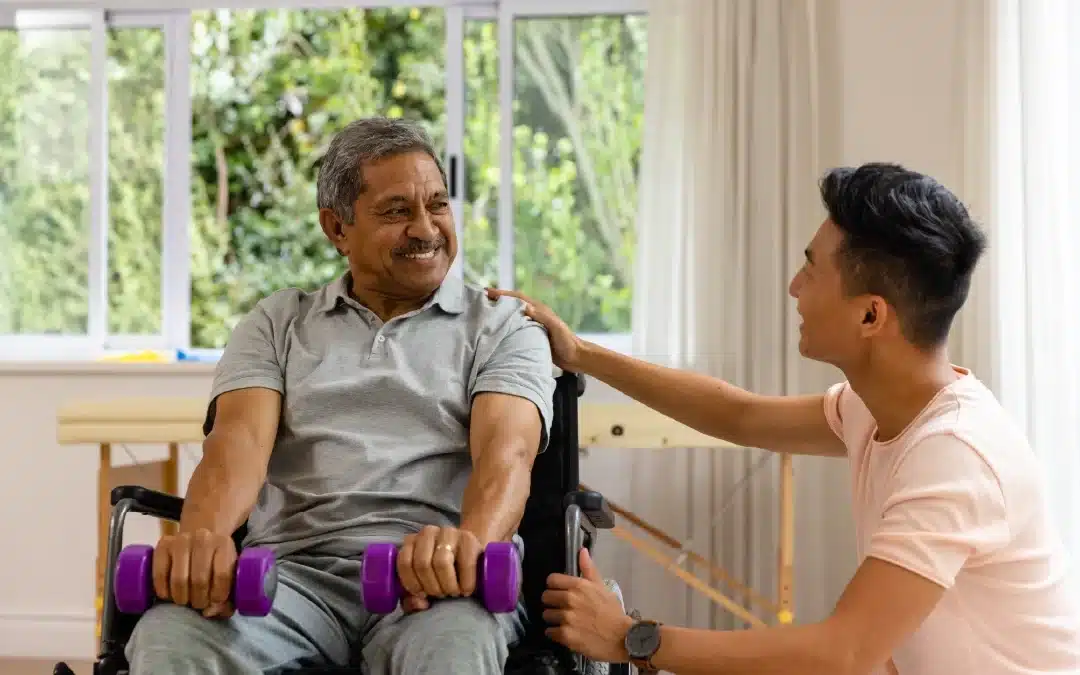With increased life expectancy, the number of older adults increases the prevalence of physiotherapy-treatable age-related conditions. Geriatric physiotherapy is a necessity for senior patients with arthritis, osteoporosis, Alzheimer’s disease, hip and joint replacements, balance disorders, and incontinence.
The need and desire of seniors to remain independent and mobile creates the need for physiotherapy.
This blog looks at geriatric physiotherapy as an essential aspect of senior care.
What is Geriatric physiotherapy?
Geriatric physiotherapy is a form of physical therapy designed for older adults and their unique health issues and challenges. It considers that older adults tend to become less active over time, experience decreased muscle strength, coordination, and reaction timing, and have a lower tolerance for physical activity.
Geriatric physiotherapy differs from other forms of physical therapy because the activities and treatment methods are formulated considering their health conditions, physiological status, energy levels, and sensitivity to physical activities. It focuses more on building strength and endurance in older adults to help them:
- Keeping active
- Preventing deconditioning, i.e. the loss of physical strength due to illness, injury, or inactivity
- Preventing muscle atrophy (the loss of muscle mass due to inactivity)
- Decreasing the risk of falls
- Maintaining independence in performing daily activities
What does Geriatric Physiotherapy include?
Physiotherapists experienced in geriatric physiotherapy can design programs for seniors based on detailed information about their health conditions, lifestyle, and expectations of physiotherapy outcomes.
Geriatric physical therapy generally consists of exercises that improve strength, flexibility, endurance, and balance to aid daily activities and movements and prevent overall deconditioning.
Exercises typically include:
- Lower body stretches, especially for the lower back, hamstrings, and his, to promote mobility and joint alignment and to prevent tight muscles or stiff joints from interfering with their movements.
- Endurance training to keep the heart and lungs healthy and improve circulation using equipment like treadmills and stationary bikes.
- Lower body strengthening exercises target the glutes and quads (muscles in the thighs and buttocks) to maintain strength, such as sit-to-stands, squats, step-ups, leg lifts, and bridges.
- Balance exercises to help you maintain your stability when standing, walking, and changing directions, including static balance exercises on flat and uneven surfaces, weight-shifting exercises, marching, and tandem walking heel to toe.
In addition to guided exercises, geriatric physiotherapy includes many other treatment methods. Some of the standard therapies include
- Manual therapy, which includes gentle soft tissue and joint mobilization and stretching by a skilled physical therapist to control pain and improve motion
- Neuromuscular Reeducation (NMR): A hands-on approach to treating and managing soft tissue injuries and retraining impacted muscles to improve coordinated movement
- Other modalities, such as ultrasound or electrical stimulation, ice, cold, laser and other interventions, may be suggested by physiotherapists to decrease pain and inflammation of joints.
Physiotherapy programs may also include sessions on exercises that the seniors can try at home, postures and activities to be avoided to reduce the risk of injuries and food habits that can enhance the effectiveness of physiotherapy.
Please read our blog on superfoods for the elderly to improve health for nutrition profiles and health benefits of food ingredients, fruits and vegetables.
Geriatric physiotherapy can address certain conditions
Common conditions in older adults include musculoskeletal problems, mental illness, incontinence, impaired body balance, chronic pain, and sleep deprivation. Physiotherapy treatments have been successful in resolving or managing each of these ailments.
Here are the few common challenges in older adults that physiotherapy addresses.
Chronic pain
Seniors commonly experience joint pain and discomfort, which leads to restricted movement. Geriatric physiotherapy reduces inflammation of joints and restores their strength and functions, releasing the restrictions on mobility.
Loss of strength and flexibility
Strength and flexibility in muscles, bones and joints reduce with age. Further, other chronic conditions, such as neurological, endocrine, and musculoskeletal issues, worsen the weakness. Geriatric physiotherapy reduces pain from the underlying causes, enables seniors to move easily, and helps to bring back strength and flexibility through exercises.
Postural Instability and Balance Impairment
Balance impairment in seniors arises due to the loss of muscle coordination and age-related natural nervous system degeneration. Physiotherapy treatments stimulate nerves and muscles, restoring the rhythm between nervous and musculoskeletal systems. Balance exercises enhance the vestibular system, which regulates body balance. They also strengthen the muscles and bones, improving seniors’ confidence to move without fear of falling.
Benefits of geriatric physiotherapy
Lowers dependence on medication:
Most older adults take medications for age-related conditions, such as diabetes, high blood pressure, digestion problems, and chronic pain. Physiotherapy reduces the impact of these conditions by engaging the body and mind through activities and exercises.
Improves quality of Life
Physiotherapy helps restore joint mobility and body balance by focusing on pain relief, often compromised with age. This restoration significantly reduces the risk of falls—a primary concern for older adults. Moreover, it enables seniors to move more freely and with less discomfort. These improvements help regain independence in daily activities, a critical factor in older adults’ mental and emotional well-being.
Summing up
Geriatric physiotherapy focuses on helping older adults strengthen the muscles they need to complete everyday tasks, such as walking, climbing stairs, and shifting positions. Therefore, attending geriatric physical therapy can help older adults remain independent and prevent other conditions from lack of physical activity, such as muscle atrophy.
At Kites Seniorcare, we offer geriatric physiotherapy services at home and at our dedicated senior care centres. We develop physiotherapy protocols to treat several diseases, including cardiac ailments, breathing problems, ortho, and neurological conditions.
Consult our expert physiotherapists with your queries and requirements for the best physiotherapy services.

